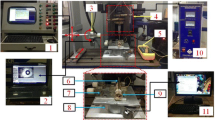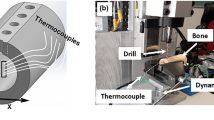Abstract
Introduction
Drilling of bones in orthopaedic and trauma surgery is a common procedure. There are yet no recommendations about which drill bits/coating should be preferred and when to change a used drill bit.
Materials and methods
In preliminary studies typical “drilling patterns” of surgeons concerning used spindle speed and feeding force were recorded. Different feeding forces were tested and abrasion was analysed using magnification and a scanning electron microscope (SEM). Acquired data were used for programming a friction stir welding machine (FSWM). Four drill bits (a default AISI 440A, a HSS, an AISI 440B and a Zirconium-oxide drill bit) were analysed for abrasive wear after 20/40/60 machine-guided and hand-driven drilled holes. Additionally different drill coatings [diamond-like carbon/grafitic (DLC), titanium nitride/carbide (Ti–N)] were tested.
Results
The mean applied feeding force by surgeons was 45 ± 15.6 Newton (N). HSS bits were still usable after 51 drill holes. Both coated AISI 440A bits showed considerable breakouts of the main cutting edge after 20 hand-driven drilled holes. The coated HSS bit showed very low abrasive wear. The non-coated AISI 440B bit had a similar durability to the HSS bits. The ZrO2 dental drill bit excelled its competitors (no considerable abrasive wear at >100 holes).
Conclusions
If the default AISI 440A drill bit cannot be checked by 20–30× magnification after surgery, it should be replaced after 20 hand-driven drilled holes. Low price coated HSS bits could be a powerful alternative.









Similar content being viewed by others
References
Augustin G, Zigman T, Davila S et al (2012) Cortical bone drilling and thermal osteonecrosis. Clin Biomech (Bristol, Avon) 27(4):313–325. doi:10.1016/j.clinbiomech.2011.10.010
Augustin G, Davila S, Mihoci K et al (2008) Thermal osteonecrosis and bone drilling parameters revisited. Arch Orthop Trauma Surg 128(1):71–77
Augustin G, Davila S, Udilljak T et al (2012) Temperature changes during cortical bone drilling with a newly designed step drill and an internally cooled drill. Int Orthop 36(7):1449–1456. doi:10.1007/s00264-012-1491-z
Matthews LS, Hirsch C (1972) Temperature measured in human cortical bone when drilling. J Bone Joint Surg 54A:297–308
Berman AT, Reid JS, Yanicko DR Jr et al (1984) Thermally induced bone necrosis in rabbits: relation to implant failure in humans. Clin Orthop 186:284–292
Eriksson RA, Albrektsson T, Magnusson B (1984) Assessment of bone viability after heat trauma. A histological, histochemical and vital microscopic study in the rabbit. Scand J Plast Reconstr Surg 18:261–268
Natali C, Ingle P, Dowell J (1996) Orthopaedic bone drills—can they be improved? Temperature changes near the drilling face. J Bone Joint Surg Br 78(3):357–362
Schmelzeisen H (1990) Der Bohrvorgang in der Kortikalis. Springer, Berlin
Fuchsberger A (1968) Die Zerspantemperatur beim Bohren von Knochen. Medizinische Orthopädische Technik 106(H.2):54–47
Lee J, Rabin Y, Ozdoganlar OB (2011) A new thermal model for bone drilling with applications to orthopaedic surgery. Med Eng Phys 33(10):1234–1244. doi:10.1016/j.medengphy.2011.05.014
Bachus KN, Rondina MT, Hutchinson DT (2000) The effects of drilling force on cortical temperatures and their duration: an in vitro study. Med Eng Phys 22(10):685–691
Lavelle C, Wedgwood D (1980) Effect of internal irrigation on frictional heat generated from bone drilling. J Oral Surg 38(7):499–503
Eriksson AR, Albrektsson T, Albrektsson B (1984) Heat caused by drilling cortical bone. Temperature measured in vivo in patients and animals. Acta Orthop Scand 55(6):629–631
Davidson SR, James DF (2003) Drilling in bone: modeling heat generation and temperature distribution. J Biomech Eng 125(3):305–314
Alajmo G, Schlegel U, Gueorguiev B et al (2012) Plunging when drilling: effect of using blunt drill bits. J Orthop Trauma 26(8):482–487. doi:10.1097/BOT.0b013e3182336ec3
Clement H, Heidari N, Grechenig W et al (2012) Drilling, not a benign procedure: laboratory simulation of true drilling depth. Injury 43(6):950–952. doi:10.1016/j.injury.2011.11.017
Pichler W, Grechenig W, Clement H et al (2009) Perforation of the third extensor compartment by the drill bit during palmar plating of the distal radius. J Hand Surg Eur 34(3):333–335. doi:10.1177/1753193408099821
Eriksson RA, Adell R (1986) Temperatures during drilling for the placement of implants using the Osseo integration technique. J Oral Maxillofac Surg 44(1):4–7
Hallab NJ, Jacobs JJ (2009) Biologic effects of implant debris. Bull NYU Hosp Jt Dis 67(2):182–188
Wiggins KL, Malkin S (1976) Drilling of bone. J Biomech 9(9):553–559
Wang W, Shi Y, Yang N et al (2014) Experimental analysis of drilling process in cortical bone. Med Eng Phys 36(2):261–266. doi:10.1016/j.medengphy.2013.08.006
Author information
Authors and Affiliations
Corresponding author
Ethics declarations
Conflict of interest
None.
Rights and permissions
About this article
Cite this article
Clement, H., Zopf, C., Brandner, M. et al. Performance test of different 3.5 mm drill bits and consequences for orthopaedic surgery. Arch Orthop Trauma Surg 135, 1675–1682 (2015). https://doi.org/10.1007/s00402-015-2338-z
Received:
Published:
Issue Date:
DOI: https://doi.org/10.1007/s00402-015-2338-z




